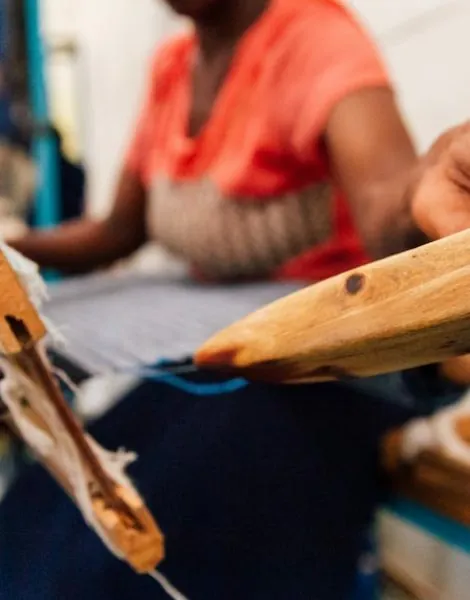In a world where plastic seems to be the reigning champion of convenience, it’s time to give a standing ovation to natural materials. Imagine a life where your furniture doesn’t outlive your great-grandchildren and your clothing doesn’t take a thousand years to decompose. Natural materials are not just eco-friendly; they’re the unsung heroes of sustainability, blending beauty and functionality in a way that’ll make Mother Nature proud.
From bamboo to cork and everything in between, these materials are stepping up to the plate, offering a refreshing alternative to synthetic options. They’re not just good for the planet; they add character and warmth to any space. So why not embrace the charm of nature? It’s time to swap out those plastic monstrosities for something that’s not only stylish but also kind to the Earth. After all, who wouldn’t want to live in a home that feels as good as it looks?
Table of Contents
ToggleOverview of Natural Material Use
Natural materials play a crucial role in promoting sustainability and reducing environmental impact. Bamboo stands out as a leader due to its rapid growth and renewability. This grass can grow up to 35 inches in a single day, making it an efficient resource for various applications. Similarly, cork, harvested from the bark of cork oak trees, regenerates over time without harming the tree.
Incorporating natural materials into design enhances aesthetic appeal and provides physical benefits. Wood, for instance, adds warmth and texture to spaces while improving indoor air quality. Studies show that natural materials can reduce allergens and promote well-being, aligning with the need for healthier living environments.
Manufacturers increasingly focus on sustainable sourcing. Certifications like FSC (Forest Stewardship Council) ensure responsible logging practices, encouraging consumers to make informed choices. Unlike synthetic alternatives, natural materials often involve less energy-intensive production processes, resulting in lower carbon footprints.
Natural materials also offer versatility. They can be found in furniture, flooring, textiles, and more, catering to various tastes and styles. Products made from hemp and jute contribute durability and style while being biodegradable.
Investment in natural materials extends beyond immediate benefits. Long-term advantages include a decrease in landfill waste and an increase in biodiversity. Choices made today contribute to a more balanced ecosystem, benefiting future generations. Thus, the shift towards natural materials fosters a connection between people and their environment, ultimately promoting a sustainable lifestyle.
Benefits of Natural Materials
Natural materials offer significant advantages, particularly in environmental sustainability and health benefits. Their use aligns with a growing emphasis on eco-friendly practices.
Environmental Sustainability
Natural materials contribute to environmental sustainability through lower carbon footprints and responsible sourcing. Bamboo’s rapid growth allows for quick replenishment, while cork harvesting maintains tree health. Certifications like FSC ensure sustainable practices, promoting the responsible management of forest resources. Less energy-intensive production processes for natural materials minimize emissions. Versatile applications range from furniture to textiles, reducing reliance on plastics. Products made from hemp and jute possess durability and biodegradability. Investing in these materials fosters biodiversity and reduces landfill waste, positively impacting ecosystems.
Health Advantages
Natural materials enhance indoor air quality by reducing allergens and toxins. For example, bamboo and cork help create a healthier living environment. These materials do not emit harmful volatile organic compounds found in synthetic options. Health benefits extend to overall well-being, as they can reduce stress and promote tranquility. Incorporating natural materials into design connects individuals to nature, fostering a sense of peace. Additionally, the aesthetic appeal of these materials can improve mood and satisfaction in living spaces. Embracing natural materials ensures a healthier lifestyle while contributing to eco-friendly practices.
Types of Natural Materials
Natural materials come in diverse forms, each offering unique benefits and applications. Understanding these types enhances informed decisions about eco-friendly choices in design and construction.
Wood
Wood stands as a classic choice for sustainable building and furnishing. This versatile material includes options like oak, maple, and pine, each with distinct characteristics. Sourcing responsibly supports forest preservation, especially with certifications like FSC. Using wood enhances aesthetics, providing warmth and natural beauty to spaces. Additionally, wood has excellent insulation properties, improving energy efficiency in homes.
Stone
Stone offers durability and timeless appeal in various applications. Granite, marble, and slate showcase rich textures and colors, making them popular for countertops and flooring. This material withstands weather conditions and wear, ensuring longevity in both interior and exterior settings. Extracting stone responsibly minimizes environmental impact. Its natural formation adds unique character, connecting spaces to the earth’s history.
Bamboo
Bamboo stands out for its rapid growth rate and renewability. This grass-like plant matures in three to five years, making it an ideal sustainable resource. Bamboo products vary from flooring and cabinetry to textiles and kitchenware. Their lightweight yet strong nature makes them remarkably versatile. This material contributes to lower emissions because it requires minimal processing while increasing indoor air quality.
Natural Fibers
Natural fibers like cotton, hemp, and jute provide eco-friendly textile options. These materials are biodegradable and renewable, offering durability without harming the environment. Hemp, for instance, requires little water and no pesticides, making it an excellent choice for responsible farming. Available in various textures and patterns, these fibers enhance aesthetics in home decor. Using natural fibers promotes healthier living spaces by reducing exposure to synthetic chemicals.
Challenges in Natural Material Use
Natural materials present certain challenges that need consideration during implementation.
Durability Concerns
Durability can vary significantly among natural materials. While bamboo offers strength and resilience, it may not withstand extreme weather conditions like metal or plastic. Wood requires treatment to resist pests and moisture, adding to maintenance needs. Furthermore, substrates like cork can compress over time, impacting their longevity. Consumers often seek assurance that these materials can last in practical applications. Ensuring proper treatment and maintenance can help mitigate potential issues with durability, allowing users to enjoy the benefits without compromising quality.
Availability and Sourcing
Availability of natural materials often presents sourcing difficulties. Not all regions have equal access to resources like bamboo or cork, limiting choices for designers and builders. Local sourcing may promote sustainability, but global demand can lead to shortages or increased prices. Ethical sourcing practices are essential to avoid overexploitation. Recognizing reliable suppliers with certifications such as FSC can ensure responsible practices. Manufacturers are encouraged to establish relationships with local growers, enhancing both availability and sustainability in the supply chain.
Case Studies of Natural Material Use
Natural materials serve as a foundation for sustainable design across various industries, impacting both aesthetics and functionality. Examining real-world applications underscores their benefits.
Architecture and Construction
Natural materials like wood and stone play crucial roles in architecture and construction. Wood, renowned for its insulation properties, reduces energy consumption in buildings. Stone offers durability and a timeless aesthetic, enhancing both residential and commercial structures. Bamboo demonstrates exceptional strength, suitable for various architectural designs. Responsible sourcing practices are vital, ensuring that materials come from sustainably managed forests. Projects showcasing these materials often illustrate how design can harmonize with nature, creating spaces that promote well-being.
Fashion and Textiles
In the fashion industry, natural fibers such as cotton, hemp, and linen lead the way in eco-friendly textiles. Cotton provides comfort while ensuring breathability, appealing to consumers seeking quality. Hemp proves exceptionally durable, making it ideal for various clothing items. Linen stands out for its low environmental impact and biodegradable nature. Brands embracing these materials often contribute to a circular economy by prioritizing sustainable sourcing and production methods. Through innovative designs, these natural textiles connect consumers to sustainable fashion choices.
Future Trends in Natural Material Use
Innovations in natural material use are emerging across various sectors. Increased consumer awareness is driving designers to prioritize eco-friendly options. Sustainability certifications, like FSC, are becoming essential benchmarks for sourcing materials responsibly.
The construction industry is shifting toward integrating natural materials into new builds. Architects are increasingly incorporating wood and stone for their insulation benefits and durability. New designs that utilize bamboo are appearing, showcasing its strength and growth efficiency.
Fashion brands are also adapting to trends in sustainable sourcing. They now favor natural fibers such as cotton, hemp, and linen for their low environmental impact. This shift in the fashion industry reflects a growing consumer demand for ethical production methods.
Research into innovative materials continues to advance. Bio-based composites are gaining attention for combining natural and synthetic fibers, offering durability without compromising sustainability. The development of mycelium-based products stands out, providing biodegradable alternatives to conventional plastics.
Regional sourcing is becoming more critical as consumers seek local options. Understanding local ecosystems allows for greater alignment with sustainable practices. Building relationships with local growers can enhance material availability and sustainability in the supply chain.
Overall, these trends signal a robust future for natural materials in various industries. The continuous pursuit of eco-friendly solutions aligns with a broader commitment to reducing environmental impact and promoting healthier living environments. Designers and consumers alike are playing crucial roles in shaping this sustainable future.
Embracing natural materials is more than just a design choice; it’s a commitment to sustainability and well-being. By opting for eco-friendly alternatives like bamboo, cork, and natural fibers, individuals can enhance their living spaces while contributing to a healthier planet. The shift towards these materials reflects a growing awareness of environmental impact and the importance of responsible sourcing.
As innovation continues to drive the use of natural materials, the potential for stylish and sustainable options expands. This evolution not only fosters aesthetic appeal but also promotes better indoor air quality and overall health. Choosing natural materials is a step toward a more sustainable future, benefiting both individual lifestyles and the environment.









